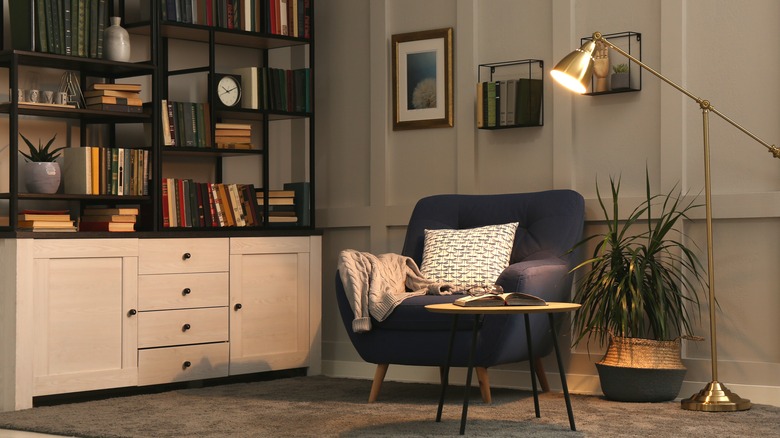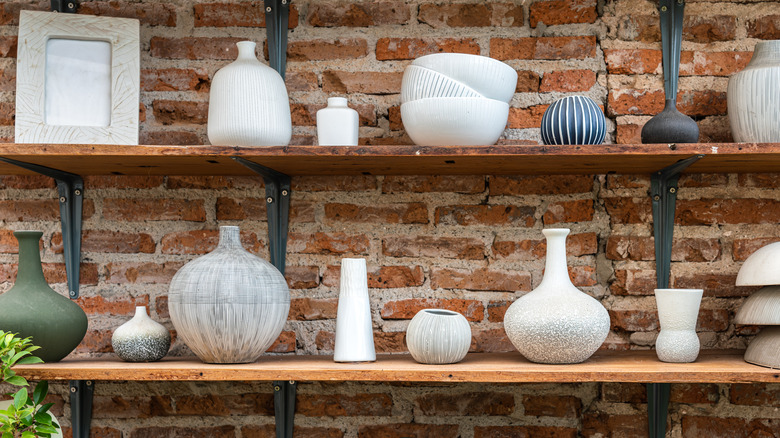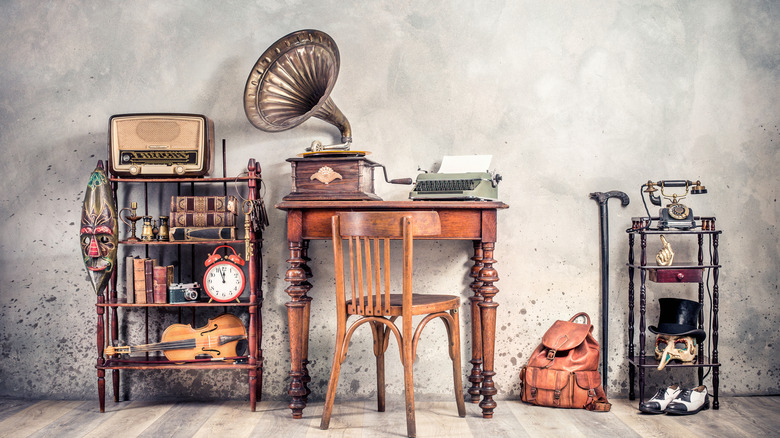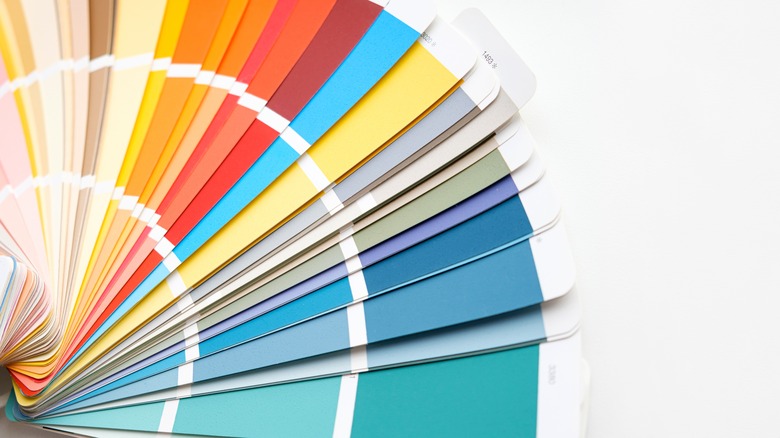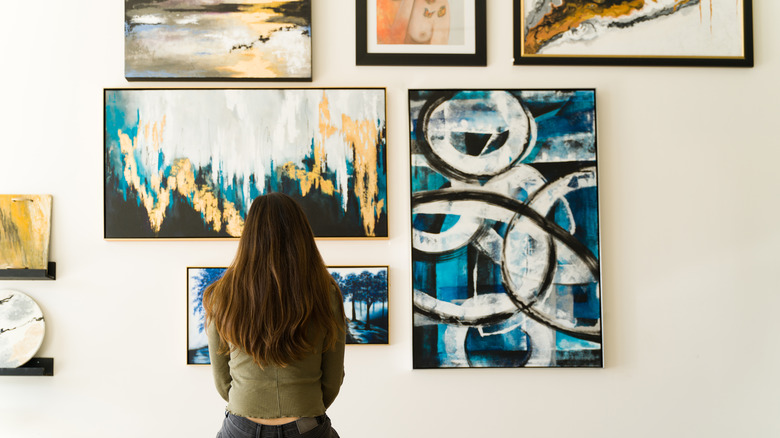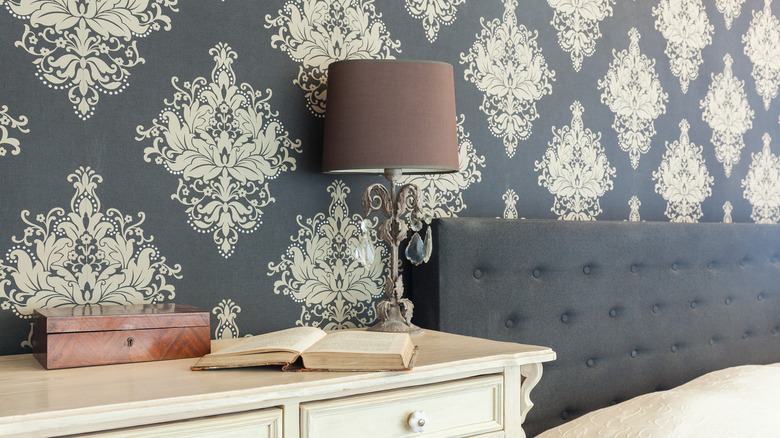How To Use The Old Money Décor Trend In Your Home
When someone mentions the term 'old money,' you may immediately think of layered polo shirts and luxurious summer homes or alpine cottages. And don't forget the intensely curated appearances of the closest thing Americans have to royalty: Jackie O and the Kennedys, Paris Hilton, the Rockefellers, or even CNN's Chris Cuomo and Anderson Cooper (of the Vanderbilts). But old money décor and style aren't about people or the vistas a home might offer. Styling your home in this way is something of deeper meaning and can add a unique sense of personality and command to your living space.
The old money décor aesthetic is trending heavily on TikTok, according to Harper's Bazaar, but the glib overview of what this entails doesn't do the concept justice. Old money, in essence, is characterized by inheritance and families enjoying financial wealth and material possessions passed down through the generations. Contrasted with what's known as new money, there's a divide in the features of design and lifestyle that feel important to the individual. New money design choices often prize ostentatious and gaudy displays, showcasing the earned wealth that an individual wields, according to SoFi. Old money décor focuses instead on the history of a piece and the personalized interaction it enjoys with the rest of the property. Those decorating with old money flair do so by humbly honoring history, beauty, and uniqueness.
Curation is key
Personalization is one of the most important features of an old-money aesthetic. Old money decorating requires curation above all else. Because this design theme takes inspiration from the historical personalization of family homes, a continued tradition of curation lies at its heart. Simple Home Simple Life suggests that a homeowner should only feature special items while providing the space required to showcase each new addition, really bringing it to life in the process. Whether you're talking about antiques or new gadgets, this decorating approach is a versatile way to make the home a special place to spend time.
For the classic old money décor, curation means identifying items (large pieces of furniture or small trinkets that round out the room) that provide a personal touch. Shopping at local thrift stores or frequenting online retailers that specialize in the specific style you're seeking will give you a rolling inventory of goods to hand-select from. The understanding that it won't happen overnight is indelible in recreating your home in this image. Taking your time in choosing only the items that speak to you and slowly adding new, curated pieces to your home will give you the aesthetic you desire and the sweat equity needed to fully appreciate the environment — perhaps even for generations to come.
Antiques are central to the aesthetic
Harper's Bazaar reports that a central theme in old-money clothing is "quiet luxury" rather than brash and in-your-face style selections. The difference might be seen in the color and outward label usage, via Global Glam. New-money garments feature large labels, flashy colors, and up-to-the-minute fashion. In comparison, old-money clothing and home furnishings alike rely on timeless classics to make subtle yet readily accessible statements. Antiques are a must-have in any home with an old-money decorating theme. They are often unique and personal. Even an antique chest of drawers or coat rack that you find locally or online exudes personality and history. With a little antiquing spirit, you can take this individuality on board and make the piece your own.
Antique items ooze with the heritage theme of old money décor. In the truest sense of the format, a home might be decorated with antique furniture passed down through multiple generations, and this might easily date some of these pieces as 100 or more years old. The primary feature of this style isn't to thumb your nose at others with less privilege or financial means but to buy something of value once and maintain it for a lifetime and beyond. This means that homeowners can gift essential items to their loved ones, making their financial balance more manageable in the process and deepening the family's traditions.
Color selection helps define the theme
Colors are a powerful feature in any decorative style. Platt College notes that color psychology plays a starring role in designs of all varieties, from the home environment to advertisements people see on TV daily. Colors influence behavior and sentiment because they reach the core emotional center of a person's soul and can also bring up feelings from one's childhood.
This makes color important in nailing a new décor in your home, and the old-money style is no different. House of Coco notes that the fashion and design palate used in old money stylings revolve around subdued tones, specifically, beige, cream, and white, with navy, black, and other classics acting as a flourish to break up the homogeneity of the primaries. iColorpalate notes a mossy or seaweed green shade named "Old Money," as well as a few other blue and green-dominated shades that share similarities or might complement the color. Because the feelings that color can impart are so powerful, matching your antique pieces with a color scheme that accentuates the vintage look and old-money personality can bring the theme together successfully.
Artwork and picture frames make the space personal
Many old-money interiors feature subtle uses of artwork. These can be paintings from highly prized artists or canvasses that speak to the homeowner or feature family portraits and images of life through the eyes of your loved ones. ABI Interiors notes that the old-money style is grounded in private stylization. It's creating a space that uniquely serves the people who frequent it — an insider's parlor where the only members are you and your closest family. As such, you can imagine the space's subtle nuances in any way you see fit, particularly when selecting wall features. Artwork has often graced the halls of some of the world's most affluent and famous, and today, homeowners across the country hang up pictures that recount their lives with pride.
Mixing and matching some of these images with a few vintage-inspired prints can transform your home. It may also be a good idea to research your family history. Painters, photographers, and artists of all disciplines have existed for as long as humans have gathered. Chances are you have a creator somewhere in your family tree. Hanging up a few prints of their work can add a nod to your family heritage that exudes the inner psychology of the old-money design aesthetic. However, when using picture frames to hang up art, always spring for designs that fit the vintage theme you're trying to achieve.
Vintage-inspired wallpaper can round out the charm
Wallpaper has often ebbed and resurfaced as a design feature of interest in homes. Vintage design and old-money aesthetics lean heavily on stylish wallpaper; however, there's a fine line between cliché and awe-inspiring when it comes to this decorative element. The Wall Street Journal offers some insight into the use of wallpaper and other trappings that feature prominently in Doris Duke's famously vintage and decidedly old-money bathroom. Duke's space utilizes a total coverage approach, and the wallpaper itself is styled with a white background and dark textures that resemble ivy leaves or grapes on the vine.
The key here is in the nod to old money color stylings while utilizing a pattern that lends itself to the mentality of old money thinking. Ivy is a prominent growth in the northeast and may even be seen cultivated and trained up the side of a historic landmark or home. Grapes speak to the traditions of old-world winemakers. No matter how to perceive the dots and lines of the style, the subliminal feelings that the wallpaper imparts are those of luxury and vintage financially-accessible charm.
